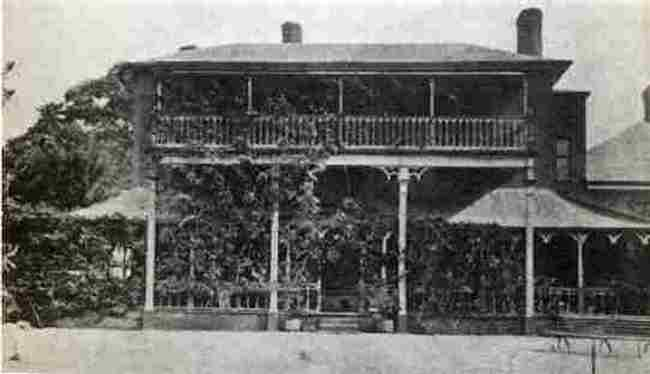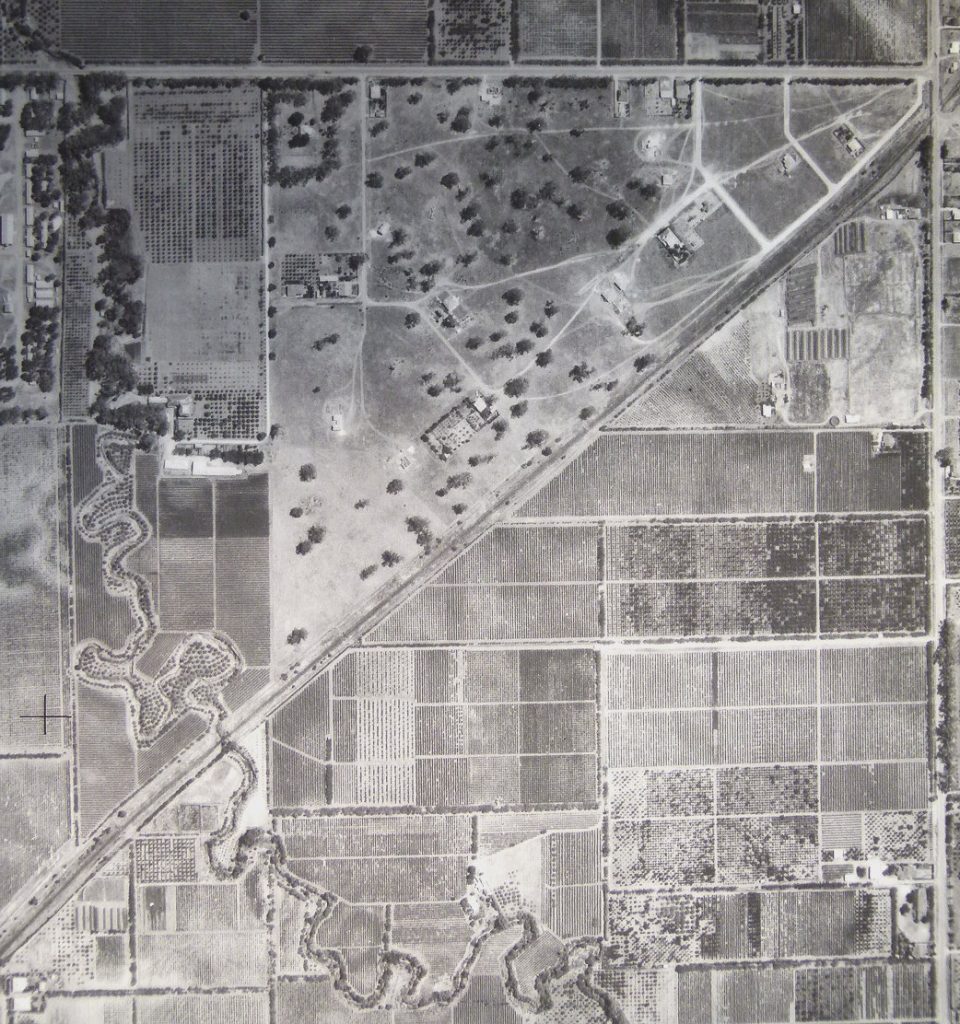This land was inhabited by the Kaurna aboriginal people who left evidence of their interaction with the land.
Oaklands
In 1843 Samuel Kearne, a Liverpool wine merchant bought 240 acres from the Crown unseen. The land comprised the area bounded by what is now Oaklands Road, Morphett Road, Marion Road and Dwyer Road, except for a small area in the south-eastern corner which was laid out as Marion village. He built a homestead which he named Oaklands. Upon completion, it was the largest homestead in South Australia. He established a successful farm producing crops, vines and fruit.

For a full history of the Oaklands Estate read “The History of ‘Oaklands’ and its Tragic End” by David Jarman, which can be purchased for $10 from the City of Marion Administration Centre, 245 Sturt Road, Sturt.
In 1866, when John Crozier bought the property, it was fully planted with irrigated oranges in the front orchard, vineyards nearby and accompanying pastures for sheep, cattle and horses. The house had a cellar that held 50,000 gallons (180,000 litres) of wine.
The property was sold to Thomas Currie Tait in 1906. In 1913 the property was split by the new Adelaide – Willunga rail line. Many of the large gum trees were used as sleepers for the line.
In 1923 Tait offered the property to the Government but they refused. The land was split up. Hamilton’s Winery bought the vineyards, the homestead with 47½ acres was sold to William Pethick and the 132 acres of the present Oaklands Estate was sold to developers.
The developers planned a subdivision that included the land that later became the Warradale Army Camp and had provision for a railway station a little south of where it was eventually built. Can you find your house block on the plan?
By 1949, as can be seen in this photograph, few homes had been completed, but a number of these still exist. It is possible to drive through the area and find homes that were completed as early as 1927.
In 1951, the Oaklands Homestead and remaining land was sold to the State Government.
Residents’ Association
When a number of gum trees in Oaklands Estate were being uprooted in 1952, a group of local residents formed the Oaklands Estate Residents’ Association (OERA) with the aim of saving some of the trees. Members volunteered to plant and care for 1,200 native street trees including a shrubbery around Marion Railway Station. Today many of these trees have reached maturity and continue to cover our streets. They also helped to initiate the gazetting of a sizeable portion of land adjacent to the Sturt River for recreational use. The City of Marion has taken responsibility for that area, known as Oaklands Estate Reserve..
The Sturt River often flooded during the winter, inundating the fields and farm buildings of Oaklands. The homestead, built a metre above ground level remained dry. The concrete lining of the river began in 1968.
The Homestead and what is now the Wetlands and Reserve had been leased to Horace Pethick but when he left, it remained vacant and was vandalised. The building was demolished by the South Australian Government in 1967 in anticipation of a freeway development that never happened (the MATS Plan). It was bulldozed into its own cellar and is buried beneath the carpark adjacent the reserve.
A Road Safety School was opened in the northern section of the property in 1972. In 2011 the area was ceded by the Government of South Australia to the City of Marion and has been developed as wetlands.
Further development of the area has progressed with an Activity Plaza being created on the northern edge. This comprises a skateboard park and a basketball zone and has been expanded with more public facilities. A large rotunda has been constructed and a larger car park on the west side of the area provides greater access to this section.
To the south, the reserve was redeveloped in 2018 and includes a new playground for children.
Oaklands Estate comprises the triangular area bounded by the Sturt River, Oaklands Road/Chambers Street and Minchinbury Terrace. It was called Oaklands Estate when it was originally sub-divided and was formally included in the suburb of Marion in around 1966. It is still commonly referred to as Oaklands Estate.
The Estate comprises around 300 homes and is estimated to house around 1000 residents. The area directly coincides with Neighbourhood Area 4 in the City of Marion draft Urban Form and Neighbourhood Character Study dated July 2007 and is designated with a Residential (Character) Zone in the Development Plan.
Since 1952, OERA has continued to be active in the area. Membership is open to all residents of the Estate. OERA is proud that many of the original Estate residents from the 1950s and 1960s, when many of the houses were built, are still living here and continue to take part in OERA and other community affairs and due to their efforts the Oaklands Estate is recognised as a Character Area.
We are equally pleased that over the last twenty or so years, many new families have moved in, enjoying the amenity of the Estate and the ability to live in existing family homes or to build new ones suitable for families. It is notable that most of the new residents comprise families which are able to enjoy family sized homes on family sized allotments situated close to shops and schools and public transport. OERA firmly believes that the ability for families to find suitable land and housing in this part of the City of Marion significantly adds to the diversity of housing and community in the northern part of the Council area.
OERA has a long and successful history, having been established by concerned residents involved in the rapid transition of the Estate from a rural to an urban area. Much of the lovely character of the Estate – which is specifically acknowledged and catered for in the City of Marion Development Plan – stems from the hard work of residents in the early years in establishing street trees and high quality reserve areas and in building and retaining housing types that complement the character of our area.
The efforts of our residents can be traced in OERA’s 50th Anniversary booklet titled “Memories of the Early Years” compiled by Ms Lyn Roberts in March 2003. Here are a couple of examples:
Members of the Residents’ Association in conjunction with the Marion Council planted many trees on the Estate. The choice of trees was determined by Dr Millington who lived in the area and worked at Waite Institute. He drew up a plan of what to plant in each street. The tree seedlings were purchased from the Woods and Forests Nursery at Belair and paid for by the Marion Council. Residents would nurture the trees in their own gardens before planting them around the Estate and the arrangement with Council was that residents would water them.
Tom Chambers, 9 February 2003
When the trees were planted on the railway side of Minchinbury Terrace, Bert Owen and I used to water the trees in their early stages. We would carry buckets of water from the properties along Minchinbury Terrace.
Lloyd Isaksson, 8 February 2003
Take a walk around our Estate and you can see the benefits derived from these tree planting efforts. While there had to be a dedicated effort in the early years – and it takes time for the benefits to be evident – with patience and continued replanting where required, wonderful streetscapes such as those in the Estate can be established and enjoyed by future generations. Over the years OERA has given every encouragement to all Estate residents to maintain the standards which were established in those early years.
OERA has always been keen to preserve the Estate as a quality residential area; to ensure the maintenance of parks and gardens and of roads, footpaths and drainage systems; to encourage neighbourly attitudes; to ensure a quality of life acceptable to all; and, importantly, to always be prepared to pursue matters likely to be of benefit to residents of the Estate.
OERA issues regular newsletters and for many years has held an annual BBQ that is open to all Estate residents. Information nights are held on important matters and a website has been developed. Close liaison with Marion Council is always important to OERA, which aims to work closely with the Mayor, Ward representatives and relevant Council staff. The OERA Committee comprises a President, Vice President, Treasurer, Secretary and a minimum of 5 other Committee Members.
We are very proud of the achievements of OERA for over 60 years and believe that it demonstrates what can be achieved in terms of establishing and maintaining a strong community spirit and neighbourhood character that will benefit future generations of Marion residents.
50th Anniversary 2002
In 2002, local resident Lyn Roberts interviewed several long term residents about the early days of the Residents’ Association and produced a booklet to commemorate the milestone.

